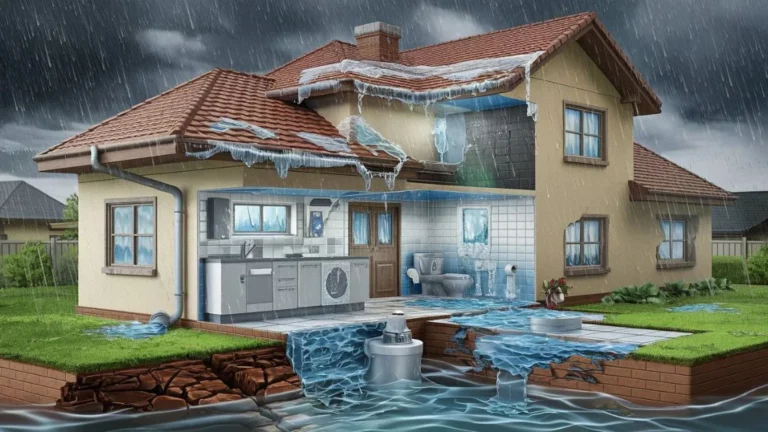Household floods can turn your world upside down, causing disruption and expensive damage to your home. Knowing the common causes of these floods is key to prevention and can save you from stress and costly repairs.
In this article, we’ll uncover the common causes behind household floods, from plumbing issues and drainage problems to natural weather events. By identifying these risks, you can take proactive steps to safeguard your home and minimise the chance of water damage.
- Household floods can arise from various factors, including heavy rainfall and climate change, which exacerbate drainage issues and raise groundwater levels.
- Structural vulnerabilities, such as foundation cracks and poorly designed drainage systems, further contribute to water ingress.
- Additionally, plumbing failures, such as corroded pipes and faulty appliances, significantly increase the risk of flooding.
- Over time, urban development has created more impermeable surfaces, intensifying runoff problems.
- Proper maintenance and proactive measures can help mitigate these risks.
Common Causes of House Flooding
Flooding poses a considerable threat to households, often resulting from a combination of environmental factors and structural deficiencies. Heavy rainfall can overwhelm drainage systems, particularly in urban areas like London, where a significant proportion of wastewater is combined sewer flow.
Structural issues, including poor drainage and foundation cracks, can exacerbate water ingress during storms. Clogged gutters and malfunctioning appliances, such as washing machines or water heaters, also contribute considerably to flooding risks.
High groundwater levels and ageing infrastructure further increase vulnerability. To combat these challenges, homeowners should invest in flood insurance and prioritise emergency preparedness.
By having a better understanding, you can prevent household floods from impacting your life.
Climate-Related Factors
Climate-related factors considerably amplify the risk of household flooding, primarily through heavy rainfall and elevated groundwater conditions.
As urban infrastructure strains under the pressure of extreme precipitation, homes become increasingly vulnerable to water intrusion from both external sources and overwhelmed drainage systems.
Furthermore, raised water tables can lead to persistent basement flooding, particularly during intense storm events, underscoring the profound impact of climate change on residential safety.
Heavy Rainfall Impacts
As heavy rainfall events become increasingly frequent and intense, the risk of household flooding has escalated dramatically. Urban planning must evolve to address these challenges, integrating creative solutions such as rainwater harvesting to manage excess water.
The impacts of heavy rainfall can be profound:
- Overwhelmed drainage systems, leading to urban flooding.
- Flash floods from sudden downpours that exceed absorption capacity.
- Public sewer backups causing sewage backflow, posing health risks.
- Increased likelihood of flooding, now four times greater than in 1970 due to climate change.
Homeowners must remain vigilant and proactive, understanding these risks in their communities.
Groundwater Conditions
How do groundwater conditions shape the risk of household flooding? Elevated water tables, particularly during heavy rainfall or snowmelt, pose a significant threat to basements.
Compacted and clay soils, characterised by low permeability, exacerbate this issue, as they struggle to absorb excess water. Climate change is further raising groundwater levels, especially in urban areas with extensive impermeable surfaces, increasing flood risks.
Seasonal fluctuations in groundwater can lead to unexpected flooding events, even in regions not typically vulnerable. For homeowners in flood-prone areas, proactive groundwater monitoring is essential; understanding groundwater conditions helps safeguard the integrity of foundations and drainage systems.
A collective awareness of these factors fosters community resilience against the growing threat of household flooding.
Structural Issues
Structural issues within a home can significantly increase the risk of flooding, particularly during periods of heavy rainfall. Homeowners must remain vigilant about the integrity of their property to prevent water damage and to protect against the consequences of water leaks.
Key factors contributing to flooding include:
- Foundation cracks that allow water seepage.
- Poor drainage systems that divert water towards the property.
- Ageing infrastructure, such as corroded pipes, prone to bursts.
- Inadequately sealed openings, such as windows and doors, vulnerable to rain.
Implementing foundation repairs and effective sealing solutions can considerably mitigate these risks.
By addressing structural vulnerabilities, homeowners can safeguard their living spaces and foster a sense of belonging, ensuring their homes remain sanctuaries against the elements.
Prioritising these repairs not only protects property but also enhances the comfort of loved ones.
Plumbing Failures
Plumbing failures are a significant yet often overlooked contributor to household flooding. Ageing pipes can corrode and leak, while tree roots may infiltrate sewer lines, creating blockages that lead to overflow.
Furthermore, faulty appliances pose a constant risk of leakage, underscoring the necessity for regular maintenance and timely inspections to mitigate potential water damage.
Aging Pipe Issues
Aging pipes can silently undermine the integrity of our homes, leading to significant plumbing failures and costly damage. Many homes, particularly those built before the 1980s, may harbour pipes that are vulnerable to issues such as:
- Pipe corrosion, which weakens structural integrity
- Tree roots infiltrating sewer lines, causing blockages
- Leaks that can escalate into severe water damage
- Annual plumbing failures affecting 1 in 50 homes
The average cost of water damage can exceed £5,000, underscoring the financial risks involved.
Regular plumbing maintenance and inspections are essential in identifying potential problems early, helping to protect our homes from the devastating consequences of aging pipe issues and ensuring a safe, secure environment for families.
Appliance Leak Risks
Household appliances play a significant role in modern living, yet they also pose substantial risks regarding leaks and flooding. Faulty appliances, particularly washing machines and dishwashers, can lead to significant water damage if hoses or connections fail.
With approximately 75% of water damage claims linked to appliance failures, the importance of regular appliance maintenance cannot be overstated. Ageing devices, such as water heaters, are especially vulnerable; improper upkeep can result in catastrophic bursts, particularly in basements.
To mitigate risks, homeowners should conduct routine inspections of water supply lines and seals, identifying potential leaks before they escalate. Moreover, installing leak detection devices near appliances can provide invaluable early warnings, safeguarding your home from extensive water damage.
Tree Root Intrusions
Tree root intrusions represent a significant yet often overlooked cause of plumbing failures in residential properties.
These intrusions can lead to severe sewer line damage, resulting in costly flooding. Understanding the risks associated with tree roots is essential for homeowners:
- Roots are naturally attracted to moisture and nutrients, making sewer lines an appealing target.
- Older, weakened pipes are particularly susceptible to infiltration.
- The average repair cost for sewer line damage due to tree root intrusion can exceed £3,000.
- Regular inspections can help identify issues before they escalate.
Appliance Malfunctions
Malfunctioning appliances can easily lead to significant flooding issues within a home, often stemming from ageing components that are prone to leaks. Common household appliances, such as washing machines, dishwashers, and water heaters, require diligent maintenance to prevent breakdowns.
Regular inspections are essential, as broken or improperly connected water supply lines can cause substantial water overflow. Additionally, the installation of leak detection devices is a proactive measure that helps identify potential issues early, minimising the risk of extensive water damage.
Being aware of your appliances’ age and condition is crucial; older units are more susceptible to malfunctions. Addressing minor issues through immediate repair or replacement can prevent them from escalating into major flooding problems, ensuring a safe and comfortable home environment.
Poor Drainage Systems
Effective drainage systems are vital for maintaining a dry and safe home environment. Poor drainage can lead to dangerous water accumulation around properties, significantly increasing flooding risks.
Regular drainage maintenance is essential to ensure water is diverted away from the home.
Key factors contributing to poor drainage include:
- Clogged drains and gutters causing overflow
- Soil saturation from storms exacerbating issues
- Inadequate systems unable to cope with melting snow and ice
- Neglected maintenance leading to costly repairs
Weather Events
Weather events play a significant role in exacerbating flooding risks, particularly in areas with already compromised drainage systems. Increasing rainfall intensity and shifting storm patterns contribute to the frequency of extreme rain events, which can lead to flash flooding. This rapid rise in water levels often overwhelms both natural and man-made drainage infrastructures.
| Weather Event | Impact on Flooding |
|---|---|
| Heavy Rainfall | Overwhelms drainage systems |
| Hurricanes | Causes widespread water accumulation |
| Flash Flooding | Rapid water rise, immediate danger |
| High Groundwater Table | Increases basement flooding risk |
In urban environments, public sewer backups during heavy rainfall can pose severe health risks, making effective storm management essential for community safety.
Human Activities
Human activities considerably contribute to the rising incidence of household floods, particularly in urban areas where development outpaces environmental considerations.
The consequences of inadequate urban planning and poor stormwater management can be severe, leading to increased flooding risks.
Key factors include:
- Construction of impermeable surfaces that enhance runoff
- Deforestation and loss of vegetation, diminishing the land’s water absorption capacity
- Poorly designed drainage systems that fail to redirect water effectively
- Human-induced climate change, resulting in more frequent and intense rainfall events
These elements interact to overwhelm existing drainage systems, causing water to pool around homes.
As communities grow, a collective effort to address these human-induced challenges will be essential to protect vulnerable households from the threat of flooding.
Preventive Measures
Flood prevention requires a proactive approach that emphasises vigilance and maintenance within the household.
Regular pipe maintenance is vital; routine inspections can uncover minor leaks before they escalate into major flooding crises. Equally essential is gutter cleaning, which should be performed at least annually to ensure proper water diversion, particularly during heavy rainfall.
Moreover, installing water alarms in basements and near appliances allows for immediate alerts to leaks, facilitating prompt responses to potential water damage. As winter approaches, insulating exposed pipes can prevent bursts caused by freezing temperatures.
Ultimately, implementing effective drainage solutions, such as French drains or regrading your garden, directs water away from your foundation, markedly reducing flood risks.
Prioritising these measures fosters a safer, more secure home environment for all.
Key Takeaways
- Heavy rainfall can overwhelm drainage systems, leading to household flooding during storms.
- Poor drainage, foundation cracks, and blocked gutters significantly increase the risk of water ingress.
- Ageing pipes and plumbing failures can result in leaks and severe water damage.
- Elevated groundwater levels and compacted soils contribute to persistent flooding, especially in basements.
- Malfunctioning appliances, such as washing machines, are common sources of water damage in homes.
Facing water damage and overwhelmed by the insurance claim process?
Our specialised Water Damage Insurance Claim Support is here to help you manage the complexity with ease!
Imagine having experts on your side who understand every detail of water damage claims. Our experienced team will handle the tedious paperwork, intricate procedures, and negotiations with your insurance company, ensuring your claim is processed accurately and swiftly.
Picture the peace of mind knowing you’re getting the full settlement you deserve without the stress. Our dedicated support means you can focus on restoring your property while we manage your insurance claim efficiently and effectively.
Don’t let water damage add unnecessary stress to your life. Reach out to our Water Damage Insurance Claim Support for a free consultation today!



